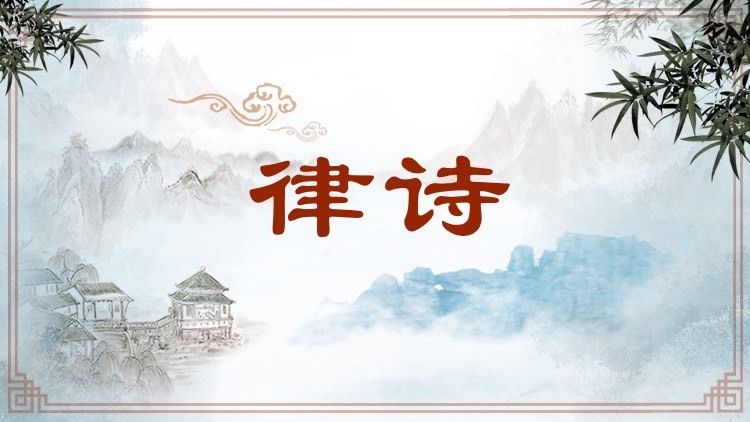律诗
Lvshi (Regulated Verse; Rhythmic Poetry)

诗体名称。有广狭二义:广义的律诗就是格律诗,指讲求格律、有严谨形式要求的诗歌;狭义的律诗则指五言、七言绝句之外的格律诗,包括五言律诗、七言律诗、五言排律、七言排律等。上古时代的诗歌韵律是自然形成的,没有严格的规范。南朝时出现了永明体,又称“新体”,开始讲求用韵规范。初唐时,经过文人的创作探索,诗歌格律逐渐定型,依据格律写作的诗被称作“今体诗”,也称“近体诗、格律诗、律诗” 。格律形成之前的诗以及后人创作的不依据格律创作的诗,则被称作“古体诗”。律诗的显著特征有几点:一是齐言句式,每句五字的称五言,每句七字的称七言等;二是押平声韵,偶数句的末字为韵脚;三是五言、七言律诗全诗八句,分属四联,依次为首、颔、颈、尾联,其中颔联、颈联必须对仗;四是诗中用字依据平仄规律排列,同一诗句中的字的平仄须交错相间,同一联上下两句之间的字平仄要相对,两联之间的平仄要相黏。超过八句的五言排律、七言排律等律诗,相当于在首、尾联中间增加对仗的联。律诗形式整齐,韵律和谐,富有节奏感,是中国古代诗歌最重要的体式之一。
This is the name of a poetic style. In a broad sense, lvshi (律诗) is poetry which stresses the requirements for rhythmic rules and forms; in a narrow sense, lvshi refers to such poetry other than quatrains with five- or seven-character lines, including five-character eight-line rhythmic poetry, seven-character eight-line rhythmic poetry, and five- or seven-character rhythmic poetry with ten or more lines. In ancient times, there were no strict regulations in regard to the rhythm of Chinese poetry. By the Southern Dynasties, however, the Yongming style, also known as the "new poetry," emerged, and began to demand the standardization of rhyme. In the early Tang Dynasty, based on the creation and exploration of some literati, poetic rules and forms gradually took shape, and rules-based poems were called contemporary or modern style poems, metrical poems or lvshi. Poems written before the establishment of poetic rules and forms or those created by later generations that did not follow the established rules and forms were called ancient style poems. The distinctive features of lvshi include the following: first, each line has the same number of characters, either five characters or seven characters. Second, the final characters of even sentences are rhyming with the level tone. Third, the poems with five- or seven-character lines each has eight lines, which can be broken down to four couplets, or pairs of related lines, namely, the first, second, third, and fourth pairs, and the second and third pairs must both be rhymed. Fourth, the characters used in the poem are arranged by level and oblique tones according to set rules. The characters in the same line must alternate between level and oblique tones. The characters of the lines in the same pair must match in level and oblique tones, and two related lines must be relative to each other. A lvshi poem with more than eight lines, whether it has five or seven characters per line, is just like adding rhymed and parallel pairs of lines between the first and last pairs. Orderly in form and harmony, and full of rhythm, lvshi is one of the most important styles of ancient Chinese poetry.
引例 Citations:
◎唐兴,官学大振,历世之文,能者互出。而又沈宋之流,研练精切,稳顺声势,谓之为律诗。(元稹《唐故工部员外郎杜君墓系铭并序》)
唐代立国之后,官学大为振兴,几代累积下来的诗文中,擅长创作的人才交替出现。而且有沈佺期、宋之问这些人钻研习练,他们创作的诗歌词句和诗意精当贴切,声韵又妥帖顺畅,因而被称作律诗。
After the establishment of the Tang Dynasty, official schools were greatly revitalized. A great number of poems and articles were created, and literary talent emerged one after another. Moreover, poets like Shen Quanqi and Song Zhiwen delved deep into the art of poetry. Their poems are now called lvshi because their wording and rhythm are precise and appropriate, as well as euphonic. (Yuan Zhen: An Inscription with Preface to the Tomb of Du Fu, the Late Staff Member of the Ministry of Works of the Tang Dynasty)
◎沈佺期、宋之问,唐律诗之祖。此诗虽无绝高处,平正整妥。(方回《瀛奎律髓》卷十六)
沈佺期、宋之问,是唐代律诗的鼻祖。这首诗虽然没有特别绝妙的地方,但是诗意平和中正,格律整齐妥帖。
Shen Quanqi and Song Zhiwen were the co-founders of lvshi in the Tang Dynasty. The poem cited here may not be particularly brilliant, but it is serene and proper, and the metrical patterns are orderly and appropriate. (Fang Hui: The Best Regulated Poems of the Tang and Song Dynasties)
推荐:教育部 国家语委
供稿:北京外国语大学 外语教学与研究出版社
责任编辑:钱耐安





